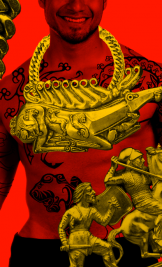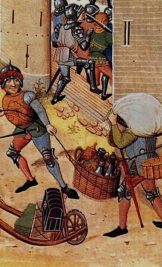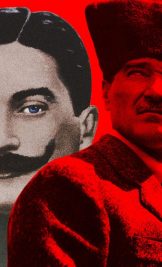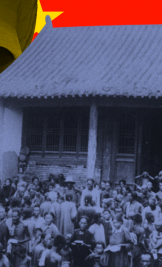

How to get into sultan’s bed and stay there for long
Girls for the sultan's harem underwent more careful selection than boys for the janissary army. Improper vagina size could write off a candidate for concubine as a maid. Oleksandra Shutko, Roxolana's life researcher and the author of the 'Hatice Turhan' novel, tells about criteria of concubine selection.
In the 16th century, Ottoman sultans stopped marrying Turkic and European princesses. From that time on, they chose for themselves slaves, captured by Crimean Tatars or Ottoman pirates. In order to get into sultan’s harem, the girls had to undergo a rigorous casting, including a humiliating medical examination.
Measuring vagina and breasts
The Quran forbids taking Muslim women prisoner and keeping them as concubines, so the harems of the sultans were replenished with Ukrainians, Greeks, Albanians, Bosnians, Georgians, and Circassians. They were not bought on the market. The most beautiful slaves were given to sultan by Crimean khans and Ottoman dignitaries who were seeking his favour.
First of all, newcomers had to undergo a thorough medical examination. The most important stage was the chastity test, conducted by midwives from the sultan’s harem. Virginity was considered the main advantage of a slave. To satisfy the sultan, her vagina did not have to be wide.
Of course, appearance was also important. Girls whose breasts were too large were considered unsuitable for the sultan, because female body had to be harmonious. Roxolana, who became a favourite of Suleiman the Magnificent, was a quite slender woman.
Only at the age of 45 Roksolana has gained a few extra pounds. A Genoese who visited sultan’s Topkapi Palace in 1550 wrote that Roxolana was a plump but beautiful woman, looking young for her age.

Testing body and mind
It was also important to protect sultan from infectious diseases. Natural methods were used to test potential concubines. After the first stage of selection, the girls with the best vaginas were infested with lice. Ottoman midwives believed that lice did not live on patients with leprosy, plague, and cholera.
At night, slaves were watched to detect mental issues. Snoring and talking in one’s sleep were considered signs of mental illness.
Slaves who successfully passed the medical examination were sent into a month-long quarantine and then to a two-year training program. They had to speak Arabic, Farsi, and Ottoman languages, read the Quran with ease, dance seductively, know poetry, and accompany their master on kemenche or qanun. The level of education in the harem can be judged by the style of the love letters, written by Roxolana to sultan Suleiman.

Battle for sex
From time to time, the sultan would organize a house party in the harem. Concubines were carefully selected by valide, who was in charge of the harem. A girl whom the ruler liked received a silk handkerchief from him. It was a sign of her losing her virginity that night.
The lucky one was first taken to the bathhouse. All hairs were removed from her body with the help of wax, and incense was used to lubricate her skin and hair. Then, accompanied by singing and dancing, the slave was led along the “golden path,” a corridor that connected the harem with the sultan’s private chambers.
Lavishly dressed and perfumed, the chosen one entered the room alone and had to crawl from the door to the bed. As a greeting sign, she would kiss sultan’s foot. After his signal, the concubine would crawl under the covers.



According to Islamic law, a man had no right to expose his private parts, so he covered them with clothes or sheets. It was also believed that if sultan saw his penis during sex, the child conceived at that moment could be born hunchbacked. Roxolana’s youngest son, Jihanhir, had a hump and was often sick. Rumors spread around the palace that it was caused by negligence of his promiscuous parents.
A pregnant girl was sent to prepare for childbirth to the Old Palace on Bayazid Square in Istanbul. She was paid and given maids. If she gave birth to a boy, she no longer had the right for intimate relationship with sultan, but was raising his heir instead. If a slave gave birth to a girl, she could share a bed with sultan again if her husband wished so.
But Hurrem-Roxolana carried out a sexual revolution, changing these rules. Since 1521, she gave birth to a boy named Mehmed, a daughter named Mihrimah, and then four more children. This whole time, Ukrainian woman did not leave sultan’s chamber. They got married only in 1530. Roxolana broke the system, and since then every concubine had a chance to receive the title of sultan, given in the 16th century to sultan’s wives, daughters, and sisters.
If a concubine did not have intimacy with sultan, she was freed from slavery after 8 years and married off. It was an honor for government officials to marry an educated and chaste foreigner who had been brought up in the sultan’s palace.


A difficult case
Growing up locked in the palace, future sultans were always afraid of being killed, and often had a traumatized psyche. According to European ambassadors, Mehmed III and his son Ahmed I have beaten their concubines to death. One of the girls refused to let the sultan go on a campaign, and the other killed the ruler’s beloved slave out of jealousy.
Ibrahim I the Mad, who ruled from 1640 to 1648, was known by his special sexual needs. He spent his entire childhood and youth in the inner chambers of Topkapi Palace, saw his brothers executed, and almost became a victim himself. After experiencing isolation and severe stress, Ibrahim initially had problems with his potency, but later he was healed, and the disaster began.
The walls of the palace were decorated with mirrors. Among them, the sultan organized races of naked girls. Then he would have sex with one or the other, neighing like a stallion.
Once, riding a horse, Ibrahim saw a heifer. The sultan was so impressed by the size of its genitals that he ordered them to be cast in gold and sent to different parts of the Ottoman Empire with the demand to find him a woman with a large vagina. Soon after, vizier Köprülü Mehmed Paşa presented the ruler with a 330-pound Armenian woman named Maria, who was named Şivekar, “the capricious one,” in the harem.
However, the love of Ibrahim I’s life was the Georgian woman named Telli, whom he married lavishly just a year before he was overthrown. During this period of his life, he had a fetish for furs, that were hanging in all the main rooms of the empire. The sultan believed that it could increase his potency.

What happened next
With the conquest of Crimea by the Russians in the 18th century, the flow of Slavic slaves to Istanbul was interrupted, but the servants of the Ottoman sultans continued to buy daughters from Georgians and Circassians.
As a result, harems of the later rulers of the Ottoman Empire consisted mainly of Caucasus women.









